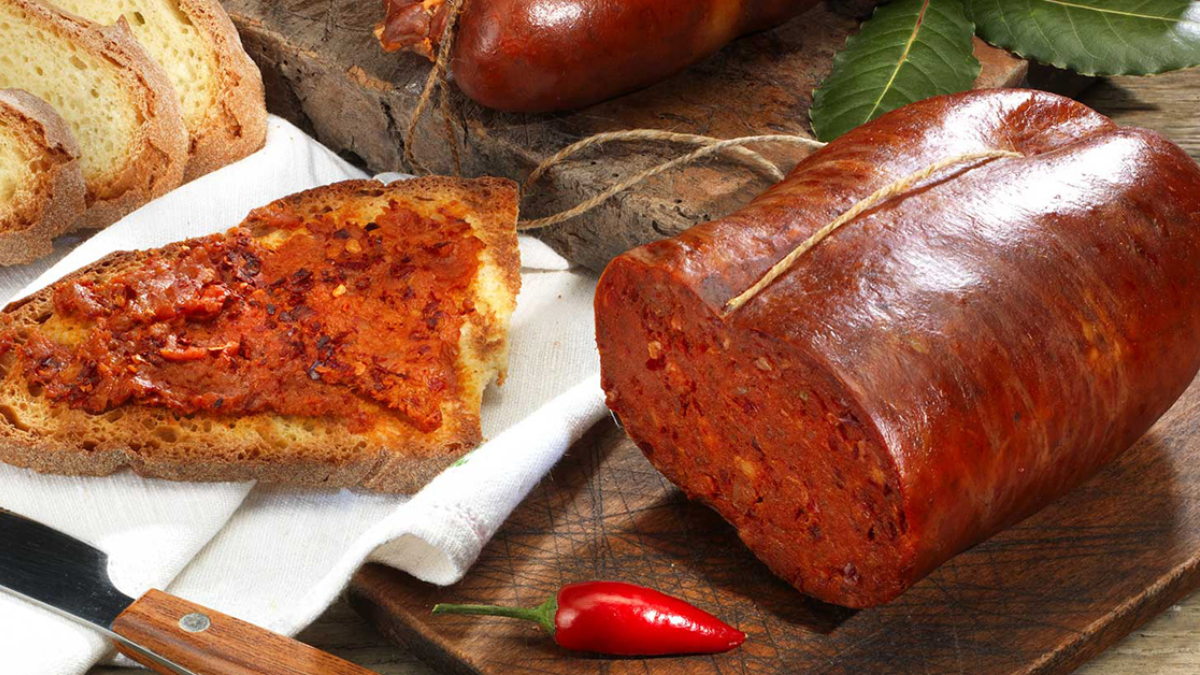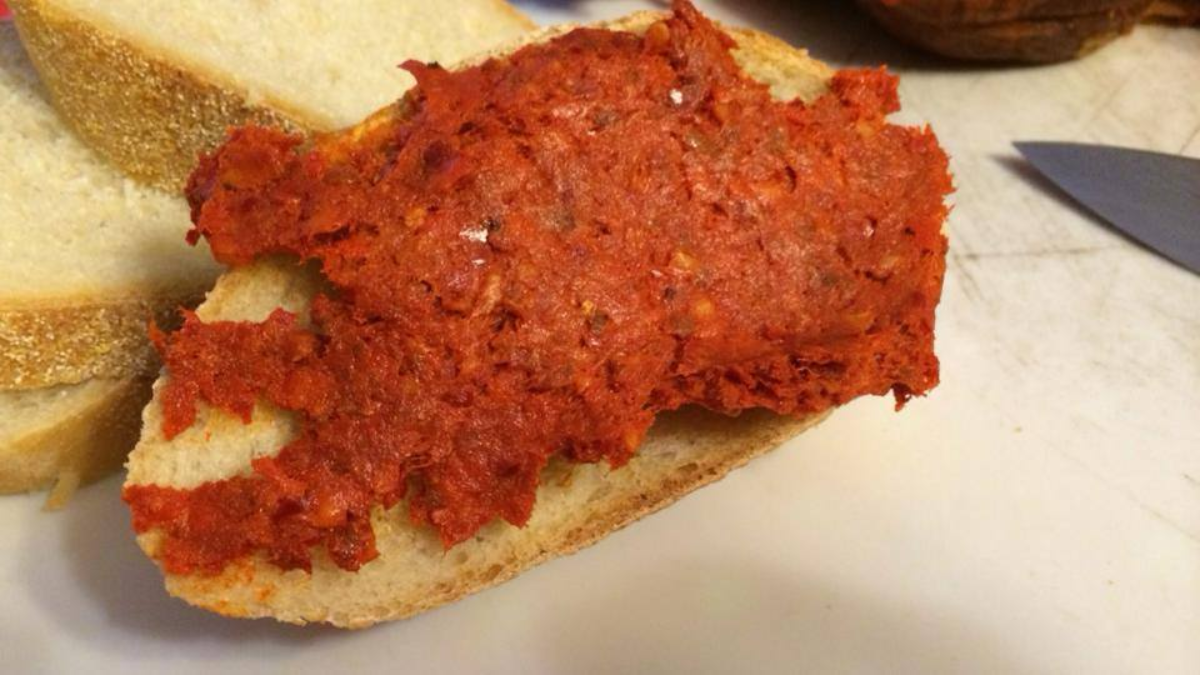Want to create something unique? You could find that this is just what you need—every mouthful of Nduja’s spicy, smokey, spreadable sausage bursts with great flavor. Nduja’s smooth texture made it the ideal ingredient for quick weeknight ragus and slow-cooked meat sauces, making it the ideal choice for sandwich spreads and crostini toppings. The base for ‘Nduja’s flavor and ingredients is typically pork. Calabrian chilies serve as its most special seasoning.
Nduja is not the only spreadable sausage available. Still, given its recent resurgence in hip eateries, upscale butcher shops, and grocery stores, it is perhaps the most popular in the United States. The high-fat content of ‘Nduja gives it its smooth, almost paste-like texture. To increase the fattiness of the sausage, most charcutiers use pork back fat or belly. Olive oil can help the components meld together into a gorgeous, silky spread.
Nduja Nutrition Facts
What is Exactly Nduja?
Around five years ago, Ndujaa—a highly spicy, spreadable pork sausage paste from Calabria (the heel of Italy! became popular in the English-speaking world). Today, it may be found on every pizza delivery menu.
This typical Italian sausage comes from the vicinity of Spilinga, which is closer to Tunis than Tuscany. Those who enjoy their cuisine have a punch; it is a tart pleasure.
Nduja is the outcome of the traditional “waste not, want not” mentality of a region where people had to maximize their access to food. Brawn, fat, offal, and all the scraps from the more expensive joints used to go into the sausage at first.
Today, it may not even contain any offal and largely comprises the fattier types of meat. Hot peppers are a natural preservative to keep the meat fresh during the colder months. You can make a sausage that looks as hot as it tastes by adding some peppers and tomatoes.
Taste
Spicy, scorching, hot, and incredibly addictive. You will find it challenging to break your ‘nduja habit once you get into it! For those unaware, consider it a condiment, similar to meaty mustard.
How to Make Nduja?
You need a few specialized ingredients and a little time to prepare this dish, but you’ll be well rewarded with a hearty, spicy, and gratifying spreadable delicacy.
Ingredients
- 4.5 lbs pork back fat, chilled
- 1.75 lbs “pork mince” (ground pork), lean and chilled
- One ox bung, soaked in cold water for 4 hours (for the casings)
- 1 1/16 oz dried chilies, blitzed into powder
- 7 1/16 oz red chilies, blitzed into a paste
- Two ⅛ oz smoked paprika
- 2 oz fine salt
- ⅓ oz curing salt
- Charcuterie twine
Method to Make
- Start by chilling a sizable mixing basin in the freezer. Put the cooled mixing bowl with the minced meat inside. Put the cooled mixing bowl with the minced meat inside. Pork back fat and pork mince should be minced in the meantime. Use the finest mincing plate with the meat mincer or grinding attachment.
- Add the fine and curing salt to the pork mixture, paprika, and dried and fresh chilies. Combine the ingredients with your hands or a stand mixer fitted with a paddle attachment until you get a gooey, orange mixture.
- Wash the ox bung under running water after draining it. Stretch out the opening once you’ve located it so you can begin filling it. Place one-fourth of the meat mixture in the ox bung, pushing it to the very end to form a tight ball. To create four mounds, repeat with the remaining three-quarters of the filling.
- Twist the ox bung a few times to make a space bet Nduja each mound to separate them. To keep the first ‘Nduja in place, bind it with a knot made of twine. To secure the second one, tie a second knot about an inch below. Continue until all four balls are in place. Except for the first ball, which will have just one knot at the end of the ox dung, every ball should have a knot on each side.
- Use a knife to divide each ‘nduja mound. Each ball’s top should be tied off, and the twine should be wrapped lengthwise around each ball before being knotted Ndujan at the top.
- Create a second sideways loop around the ‘Nduja and secure it. At the top, leave a small loop for hanging. Do this for every ‘nduja ball. Ndujatition isNdujassary undulates a total of four twine loops around the ‘Nduja.
- The ‘Nduja can now be placed in the curing room. A Ndujadity of 80% and a temperature of oNdujaF are advised. The ‘Nduja can be left hanging in the refrigerator for two weeks if you don’t have a cNduja chamber. However, the meat will come out fresher and wetter, necessitating cooking before consumption.
Is Nduja Similar to Chorizo?
Both nduja and chorizo sausage from Spain is hot, preserved pork products. They are both traditionally fermented and have a comparable Nduja. Although certain chorizos are soft and spreadable, ‘Nduja is often softer. AlthNdujait can be spreadable; chorizo is often tougher thNdujaduja. While chorizo is Ndujait’s drier flavor than the regular paprika, Nduja’Nduja has flaNdujahotness.
How to Use Nduja?
Here are fNdujaays to use nduja:
- Sonja on Toasted Bread: Spreading Nduja over a piece of toasted bread is a Ndujatastic to serve your visitors a dNdujaable snack, even though it seems like a simple suggestion. The warmth of the bread helps the nduja release all oNduja rich taste.
- On the Pizza: Yes, a few teaspoons ofNdujaa can elevate a variety of pizzas. For instance, the Nduja from the Spilinga Ndujaict and the Tropea’s onion would ensure an excellentNdujaination of spicy and sweet in a Calabrian variation of the well-known “Tuna and onion” pizza. We advise consuming this unique pizza along with an artisan amber beer.
- With the Red Sauces: Nduja is the ideal way to enhance the flavor of any red sauce. The great Calabrian salami is ideal for adding a special touch to your dishes, whether they call for traditional tomato sauce.
- With Pasta and Beans: Have you never tried spaghetti with beans and black pork nduja from Calabria? If you try it, you’ll love this amazing dish. We advise pairing this spaghetti with a glass of Rosso Ricupo, a red wine from Calabria distinguished by a powerful aromatic band.
- With the Eggs “in Purgatorio”: Last but not least, we recommend a dish that is intended for everyone continuously seeking new sensations. We’re referring to the nduja-topped eggs “in Purgatorio,” which will add a special touch to a classic Italian dish. They go well with a glass of Seme Nero, a robust red wine from Calabria with a tannic character.
How Long does Nduja Last in the Fridge?
Nduja is a fermented, salt- and chili-seasoned preserved pork. It was created so that the meat would remain fresh even without refrigeration. Once the packet is opened, it is usually safer to store it in the refrigerator, but you should be able to keep it for a month (check what it says on the packet). You can freeze it if you are moving through it too slowly.
Whether it be a refrigerator or a freezer, As much as you can, make sure it is snuNdujarapped to keep out the air. The cut surface of your ‘Nduja may have somewhat browned after a few weeks in the refrigerator as a result of lipid oxidation. Cut it off if you notice a difference; if not, continue using it as is Nduja.
How to Store Nduja?
Here are four simple steps to store Nduja:
Keep it Wrapped in its Skin
As with all sausages, when the meat comes Ndujacontact with oxygen, it changes color, becoming a darker version of its original color. The meat is still safe to eat, so try to keep the cured Ndujawrapped in its skin. For example, instead of cutting Nduja into slices, try scooping out the desired amount with a spoon while leaving Ndujaskin intact. When finished, wrap the skin’s edge back into the meat.
Wrap in Cling Flim
After covering the exposed meat with the remaining skin, wrap the entire piece in cling film and store it in the refrigerator.
Do Not Freeze
The term “nduja” refers to cured meat, which is meat that has been prepared without the use of heat or water, such as when fish is prepared with lemon or vinegar by freezing it, as with any cured meat, water in the form of ice will penetrate the meat, eradicating the dried cooking process that would otherwise ruin the meat and proNdujathe growth of mold.
Do Not Worry if it Gets Hard
The Nduja will begin to dry out and get firmer after being in the refrigerator for a Nduja (more than a month), but it is still safe to consume. The main drawback is that it becomes more difficult to spread, but you may still use it in cooking.
Where to Buy Nduja?
It’s fantastic news for the home chef that Nduja is having a moment because it’s now more accessible than ever. It might be Nduja in the meat section of some very well-stocked supermarkets, where you’d find items like salami or prosciutto.
You can purchase it at your neighborhood Italian specialty food store, butcher shop, or deli with a strong Italian influence. If not, a variety of internet merchants have a huge selection of various brands and varieties.
Like salami or sausages, each brand has a unique recipe based on a general formula. If you can, try a few different brands to determine which ones best fit your choice.
Conclusion
Italy’s equivalent of chorizo is ‘Nduja. ‘Nduja is a product of pork sausage that has been heavily seasoned, salty, NdujaspiNdujats intensely flavorful porkiness and funky fermenteNdujavor make it incredibly adaptable and crave-worthy. ‘Nduja is a staple of all Italian cooking and is flavored with Calabrian peppers, Ndujaer of Southern Italy’s culinary treasures.
NadjaNduja versatile condiment that can be used practically everywhere you want subtle, salty spice. It is not simply a log of delectaNdujamami excellent for spreading on bread. You can get ‘Nduja in a jar to be scooped or in a tube that can be cut apart and spread. YNdujan gets ‘Nduja in a jar to be scooped or in a tube that can be cut apart and spread.
Similar to the majority of salumi and sauNdujavarieties, ‘Nduja is prepared from the leftover scraps an,d fat from other meat cuts to flavorNdujaless-than-stellar cuts. The production of ‘Nduja is a great way for farmers and butchers to use every part of the pig and create wonderfNdujaod out of ingredients that might otherwise go to waste.



